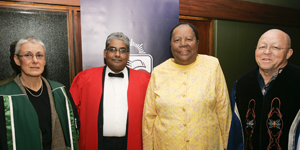
Dr Liz Lange, Prof Hussein Solomon, Minister Naledi Pandor and Prof Nicky Morgan
Photo: Johan Roux |
Minister of Home Affairs, Naledi Pandor, recently addressed staff, students and members of the community at the CR Swart Auditorium, UFS.
During a public lecture hosted by the Department of Political Studies and Governance, in collaboration with the Free State Legislature, Pandor spoke about The Role of Intellectuals and Academics in moving South Africa forward. She challenged young minds to become the innovative game changers of tomorrow and stressed the importance of tertiary education and its impact on national developments.
“Our country and the world need large quantities of undergraduate institutions,” said Pandor. “We need new innovative partnerships. Private sector research and public sector research need to be married. And we as government should promote private sector development.”
Referring to the breakthrough for South Africa on Africa Day 2012, Pandor made it clear that South Africans have the potential to be first movers, although it has not always been the case. It was announced on Africa Day 2012 that Africa had been named as the preferred site for the Square Kilometre Array (SKA) radio telescope (
http://www.ska.ac.za/releases/20120525.php). This undertaking contributed immensely in fuelling the interest in science and technology among South Africans.
“We cannot rely on the same things always. We as South Africans are not usually the first movers. We tend to adopt innovations from elsewhere. But, we need to do more to initiate innovative start-ups … especially in the fields of IT and high-tech innovations.”
Conclusively, this leads to the question of whether we as South African are doing enough to further build a new generation of intellectuals?